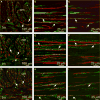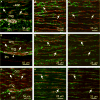Relationship between enteric neurons and interstitial cells in the primate gastrointestinal tract
- PMID: 22805588
- PMCID: PMC4854185
- DOI: 10.1111/j.1365-2982.2012.01975.x
Relationship between enteric neurons and interstitial cells in the primate gastrointestinal tract
Abstract
Background: Morphological studies have revealed a close anatomical relationship between enteric nerve terminals and intramuscular ICC (ICC-IM) which supports a role for ICC-IM as intermediaries in enteric motor neurotransmission. Recently, a second type of interstitial cell previously described as 'fibroblast-like' but can now be identified by platelet-derived growth factor receptor-α expression, has also been implicated in enteric neurotransmission in rodents. The present study was performed to determine if enteric nerve fibers form close anatomical relationships with ICC and PDGFRα(+) cells throughout the primate GI tract.
Methods: Immunohistochemical experiments and confocal microscopy were performed to examine the relationship between excitatory and inhibitory motor neurons, ICC and PDGFRα(+) cells throughout the monkey GI tract.
Key results: The pan neuronal marker. Protein gene product 9.5 (PGP9.5) was used to label all enteric neurons and substance-P (sub-P) and neuronal nitric oxide synthase (nNOS) to label excitatory and inhibitory neurons, respectively. Double labeling with Kit revealed that both classes of nerve fibers were closely apposed with ICC-IM in the stomach, small intestine and colon (taenia and inter-taenia regions), but not with ICC at the level of the myenteric plexus (ICC-MY). Varicose enteric nerve fibers were closely associated with ICC-IM for distances up to 250 μm. Both excitatory and inhibitory nerve fibers were also closely apposed to PDGFRα(+) cells throughout the primate GI tract.
Conclusions & inferences: The close anatomical relationship between enteric nerve fibers and ICC-IM and PDGFRα(+) cells throughout the GI tract of the Cynomolgus monkey provides morphological evidence that these two classes of interstitial cells may provide a similar physiological function in primates as has been attributed in rodent animal models.
© 2012 Blackwell Publishing Ltd.
Conflict of interest statement
CONFLICT OF INTEREST
The authors have no competing interests to declare.
Figures








Similar articles
-
Interstitial cells of Cajal are innervated by nitrergic nerves and express nitric oxide-sensitive guanylate cyclase in the guinea-pig gastrointestinal tract.Neuroscience. 2008 Mar 18;152(2):437-48. doi: 10.1016/j.neuroscience.2007.12.044. Epub 2008 Jan 12. Neuroscience. 2008. PMID: 18280665
-
Platelet-derived growth factor receptor α-positive cells in the tunica muscularis of human colon.J Cell Mol Med. 2012 Jul;16(7):1397-404. doi: 10.1111/j.1582-4934.2011.01510.x. J Cell Mol Med. 2012. PMID: 22225616 Free PMC article.
-
Relationship between interstitial cells of Cajal, fibroblast-like cells and inhibitory motor nerves in the internal anal sphincter.Cell Tissue Res. 2011 Apr;344(1):17-30. doi: 10.1007/s00441-011-1138-1. Epub 2011 Feb 22. Cell Tissue Res. 2011. PMID: 21337122 Free PMC article.
-
Interstitial cells of Cajal: primary targets of enteric motor innervation.Anat Rec. 2001 Jan 1;262(1):125-35. doi: 10.1002/1097-0185(20010101)262:1<125::AID-AR1017>3.0.CO;2-I. Anat Rec. 2001. PMID: 11146435 Review.
-
Involvement of intramuscular interstitial cells of Cajal in neuroeffector transmission in the gastrointestinal tract.J Physiol. 2006 Nov 1;576(Pt 3):675-82. doi: 10.1113/jphysiol.2006.117390. Epub 2006 Sep 14. J Physiol. 2006. PMID: 16973700 Free PMC article. Review.
Cited by
-
Histologic changes in diabetic gastroparesis.Gastroenterol Clin North Am. 2015 Mar;44(1):31-8. doi: 10.1016/j.gtc.2014.11.004. Epub 2014 Dec 19. Gastroenterol Clin North Am. 2015. PMID: 25667021 Free PMC article. Review.
-
Layer-specific molecular signatures of colon anastomotic healing and leakage in mice.Mol Med. 2025 Apr 1;31(1):124. doi: 10.1186/s10020-025-01167-9. Mol Med. 2025. PMID: 40169980 Free PMC article.
-
Interstitial cells: regulators of smooth muscle function.Physiol Rev. 2014 Jul;94(3):859-907. doi: 10.1152/physrev.00037.2013. Physiol Rev. 2014. PMID: 24987007 Free PMC article. Review.
-
Temporal sequence of activation of cells involved in purinergic neurotransmission in the colon.J Physiol. 2015 Apr 15;593(8):1945-63. doi: 10.1113/jphysiol.2014.287599. Epub 2015 Feb 23. J Physiol. 2015. PMID: 25627983 Free PMC article.
-
Transduction of Systemically Administered Adeno-Associated Virus in the Colonic Enteric Nervous System and c-Kit Cells of Adult Mice.Front Neuroanat. 2022 Jun 6;16:884280. doi: 10.3389/fnana.2022.884280. eCollection 2022. Front Neuroanat. 2022. PMID: 35734536 Free PMC article.
References
-
- Maeda H, Yamagata A, Nishikawa S, Yoshinaga K, Kobayashi S, Nishi K. Requirement of c-kit for development of intestinal pacemaker system. Development. 1992;116:369–75. - PubMed
-
- Huizinga JD, Thuneberg L, Kluppel M, Malysz J, Mikkelsen HB, Bern-stein A. W/kit gene required for interstitial cells of Cajal and for intestinal pacemaker activity. Nature. 1995;373:347–9. - PubMed
Publication types
MeSH terms
Substances
Grants and funding
LinkOut - more resources
Full Text Sources

